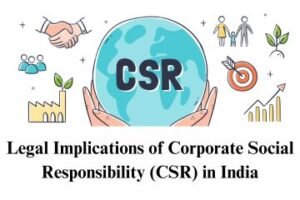The Intersection of Human Rights and Environmental Laws
Written by Nakshatra Dapse
INTRODUCTION
Human rights and environmental law have a common goal of recognizing human rights and advancing human well-being. Governments and international organizations understand the link between these two problems since improving the quality of life depends on them. One of the most essential rights is the right to life, which includes the right to a clean environment.
However, it’s common to see the relationship between environmental conservation and human rights as irrelevant. Resources have been exploited, and globalization, urbanization, and industrialization have all contributed to major environmental crises such as ozone depletion, biodiversity loss, climate change, and global warming. These concerns cover social, political, and economic aspects.
The relationship between environmental law and human rights has produced a rights-based strategy to deal with environmental issues. To reach a consensus on policies to solve the most critical environmental issues facing the globe, it is imperative to bring together governments, corporations, civil society, and other interested parties.
The way that people exercise their rights affects the environment’s significance and sustainability. The preservation of the environment and wildlife has been ranked as one of the most crucial topics since the Stockholm Environment Conference in 1972. It is the responsibility of the state to defend fundamental human rights, such as the right to life. A good existence and peace with nature are only possible by implementing appropriate environmental regulations.
ROLE OF JUDICIARY IN PROTECTING ENVIRONMENT
Various rulings have demonstrated the Indian judiciary’s vital role in defending the environment and fundamental human rights. The Indian Supreme Court held in Francis Coralie Mullin v. Union Territory [1]that the right to human dignity is a part of the right to life guaranteed by Article 21 of the Indian Constitution. In M. C. Mehta v. UOI,[2] the court stressed environmental issues while placing a higher priority on life, health, and the environment than unemployment. In the Charan Lal Sahu case, the right to a clean and pollution-free environment was recognized as a human right, and the court in Subhash Kumar v. State of Bihar[3] gave victims of environmental legislation recourse. The right to a healthy environment was also included in the right to life. Within the context of basic rights, the Indian judiciary has been instrumental in bringing attention to environmental concerns and defending citizens’ rights, particularly the right to a clean and healthy environment.
INTERCONNECTION AND INTERSECTION OF HUMAN RIGHTS AND ENVIRONMENTAL LAW
The intersection of human rights and environmental law is a crucial field of study and practice today. It involves the complex relationship between legal frameworks that protect individuals’ rights and well-being and those that safeguard the environment. Human rights are universal and inalienable entitlements, including the right to life, liberty, equality, and freedom from discrimination. The right to a healthy environment is increasingly recognized as a crucial human right in the context of the intersection between human rights and environmental law.
Environmental law, on the other hand, comprises legal principles and regulations designed to protect the natural environment and address environmental challenges, such as pollution, habitat destruction, climate change, and biodiversity loss. Key aspects of the intersection include the right to a healthy environment, access to environmental information, public participation in decision-making processes, and access to justice.
Human rights are universal and inalienable entitlements that encompass various aspects of human life, including the right to life, liberty, equality, and freedom from discrimination. Environmental laws range from local regulations on waste disposal to international agreements on climate change mitigation. Addressing these intersections requires a balance between human rights and environmental protection, ensuring that individuals and communities have access to legal mechanisms and remedies to seek redress when their rights are violated due to environmental degradation or pollution.
India’s complex environment and diverse population pose unique challenges to the intersection of human rights and environmental law. The country’s Constitution enshrines the right to life, liberty, equality, and freedom from discrimination, while the concept of a healthy environment is emerging through judicial interpretation and evolving legal principles. India also has comprehensive environmental laws and regulations addressing issues like air and water quality, wildlife protection, and forest conservation. The Constitution also places a duty on the state to protect and improve the environment. Understanding these complexities is crucial for creating a sustainable and equitable future.
CHALLENGES AND SOLUTIONS-
- Displacement and Land Rights: In India, extensive development initiatives frequently result in the uprooting of local inhabitants. These initiatives may violate human rights pertaining to housing and land, giving rise to conflicts over livelihoods and land rights.
Solution: The difficulties associated with relocation and land rights can be lessened with adequate compensation, rehabilitation, and the involvement of impacted groups in decision-making procedures.
- Air and Water Pollution: The population in Indian cities faces serious health hazards due to the country’s rapid industrialization and urbanization, which have caused serious pollution issues. In such cases, there is often tension between the right to health and the right to a healthy environment.
Solution: To solve this issue, public awareness efforts, access to clean and safe drinking water, and strict enforcement of pollution control laws are essential.
- The rights of indigenous and tribal populations that depend on forests and natural resources can occasionally conflict with conservation efforts, despite the latter being vital for environmental protection.
The answer is to respect indigenous and tribal groups’ traditional knowledge and engage them in the decision-making process when it comes to the utilization of natural resources to strike a balance between conservation efforts and these rights.
PROVISIONS FOR HUMAN RIGHTS AND ENVIRONMENTAL LAW IN INDIA
The Indian Constitution mentions the right to a safe environment under Article 21 of the right to life. According to the Indian Constitution, everyone has the basic right to live in a clean environment. The Constitution makes it very evident that human and environmental rights are interdependent. The Directive Principle of State Policy stresses the importance of environmental legislation in Article 48a. The state is required under Article 48a to make great efforts to conserve and safeguard the environment. The Indian Constitution emphasizes not just the relationship between environmental protection and human rights, but also the need for both the state and the people to take action to preserve and safeguard the nation’s natural resources.
According to the Indian Constitution, a clean environment is not just the people’s basic right but also their essential obligation. According to Article 51(g) of the Indian Constitution, it is every citizen’s responsibility to safeguard the nation’s natural resources, such as its forests and waterways, and to avoid endangering any species. The Indian Constitution deftly establishes the interdependence of environmental law and human rights. The Supreme Court said in Sachidanand Pandey v. State of West Bengal [4]that the court must always bear in mind Article 48(A) and Article 51A(g) [5]whenever environmental issues are brought before it.
CONCLUSION
The intersection of human rights and environmental law is a complex issue that impacts both individuals and the environment. The Indian judiciary has played a crucial role in advancing these rights, recognizing the interdependence of these rights. The right to a healthy environment is a fundamental human right, and a holistic approach to addressing environmental challenges is essential. Challenges in India include displacement, land rights, air and water pollution, and conflicts with indigenous and tribal rights. Solutions include compensation, rehabilitation, strict enforcement of pollution control measures, and inclusion of indigenous communities in decision-making processes. The Indian Constitution emphasizes the interdependence of environmental protection and human rights, and a balanced approach is necessary for a just and sustainable future.
[1] Francis Coralie Mullin v. Union Territory 1981 AIR 746, 1981 SCR (2) 516
[2] M.C Mehta v. UOI 1987 AIR 1086, 1987 SCR (1) 819
[3] Subhash Kumar v. State of Bihar 1991 AIR 420, 1991 SCR (1) 5
[4] Sachidanand Pandey v. State of West Bengal 1987 AIR 1109, 1987 SCR (2) 223
[5] Constitution of India, art 48(A) and art 51A(g)
Keywords: The Intersection of Human Rights and Environmental Laws, Human Rights and Environmental Laws, Human Rights and Environmental Laws in India




